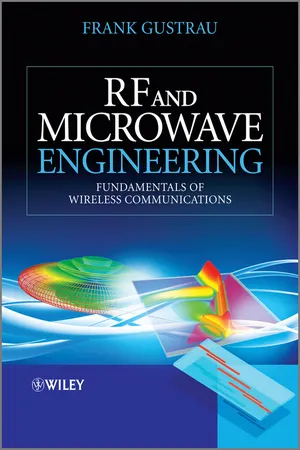
- English
- ePUB (mobile friendly)
- Available on iOS & Android
About this book
This book provides a fundamental and practical introduction to radio frequency and microwave engineering and physical aspects of wireless communication
In this book, the author addresses a wide range of radio-frequency and microwave topics with emphasis on physical aspects including EM and voltage waves, transmission lines, passive circuits, antennas, radio wave propagation. Up-to-date RF design tools like RF circuit simulation, EM simulation and computerized smith charts, are used in various examples to demonstrate how these methods can be applied effectively in RF engineering practice.
Design rules and working examples illustrate the theoretical parts. The examples are close to real world problems, so the reader can directly transfer the methods within the context of their own work. At the end of each chapter a list of problems is given in order to deepen the reader's understanding of the chapter material and practice the new competences. Solutions are available on the author's website.
Key Features:
- Presents a wide range of RF topics with emphasis on physical aspects e.g. EM and voltage waves, transmission lines, passive circuits, antennas
- Uses various examples of modern RF tools that show how the methods can be applied productively in RF engineering practice
- Incorporates various design examples using circuit and electromagnetic (EM) simulation software
- Discusses the propagation of waves: their representation, their effects, and their utilization in passive circuits and antenna structures
- Provides a list of problems at the end of each chapter
- Includes an accompanying website containing solutions to the problems (http:\\www.fh-dortmund.de\gustrau_rf_textbook)
Frequently asked questions
- Essential is ideal for learners and professionals who enjoy exploring a wide range of subjects. Access the Essential Library with 800,000+ trusted titles and best-sellers across business, personal growth, and the humanities. Includes unlimited reading time and Standard Read Aloud voice.
- Complete: Perfect for advanced learners and researchers needing full, unrestricted access. Unlock 1.4M+ books across hundreds of subjects, including academic and specialized titles. The Complete Plan also includes advanced features like Premium Read Aloud and Research Assistant.
Please note we cannot support devices running on iOS 13 and Android 7 or earlier. Learn more about using the app.
Information
1.1 Radiofrequency and Microwave Applications

| Cellular mobile telephony | ||
| GSM 900 | Global System for Mobile Communication | 880 … 960 MHz |
| GSM 1800 | Global System for Mobile Communication | 1.71 … 1.88 GHz |
| UMTS | Universal Mobile Telecommunications System | 1.92 … 2.17 GHz |
| Tetra | Trunked radio | 440 … 470 MHz |
| Wireless networks | ||
| WLAN | Wireless local area network | 2.45 GHz, 5 GHz |
| Bluetooth | Short range radio | 2.45 GHz |
| Navigation | ||
| GPS | Global Positioning System | 1.2 GHz, 1.575 GHz |
| Identification | ||
| RFID | Radio-Frequency Identification | 13.56 MHz, 868 MHz, |
| 2.45 GHz, 5 GHz | ||
| Radio broadcasting | ||
| FM | Analog broadcast transmitter network | 87.5 … 108 MHz |
| DAB | Digital Audio Broadcasting | 223 … 230 MHz |
| DVB-T | Digital Video Broadcasting - Terrestrial | 470 … 790 MHz |
| DVB-S | Digital Video Broadcasting - Satellite | 10.7 … 12.75 GHz |
| Radar applications | ||
| SRR | Automotive short range radar | 24 GHz |
| ACC | Adaptive cruise control radar | 77 GHz |
1.2 Frequency Bands
| Frequency range | Denomination |
| 3 … 30 kHz | VLF - Very Low Frequency |
| 30 … 300 kHz | LF - Low Frequency |
| 300 kHz … 3 MHz | MF - Medium Frequency |
| 3 … 30 MHz | HF - High Frequency |
| 30 … 300 MHz | VHF - Very High Frequency |
| 300 MHz … 3 GHz | UHF - Ultra High Frequency |
| 3 … 30 GHz | SHF - Super High Frequency |
| 30 … 300 GHz | EHF - Extremely High Frequency |
Table of contents
- Cover
- Title Page
- Copyright
- Dedication
- Preface
- List of Abbreviations
- List of Symbols
- Chapter 1: Introduction
- Chapter 2: Electromagnetic Fields and Waves
- Chapter 3: Transmission Line Theory and Transient Signals on Lines
- Chapter 4: Transmission Lines and Waveguides
- Chapter 5: Scattering Parameters
- Chapter 6: RF Components and Circuits
- Chapter 7: Antennas
- Chapter 8: Radio Wave Propagation
- Appendix A
- Index